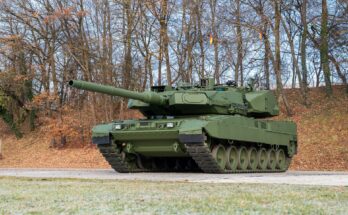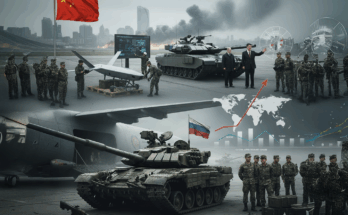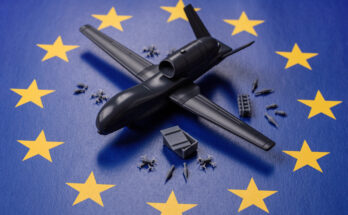
In line with the provisions of the 2015 nuclear accord, the arms embargo on Iran has now expired. The end of the restrictions comes despite a last-minute effort on the part of the U.S. to get the embargo extended or the former sanctions regime reinstated. That push saw almost no support in the U.N. Security Council, which rejected the Trump administration’s interpretations of the nuclear deal and pointed to Washington’s 2018 exit from the agreement.
Iranian officials have, unsurprisingly, loudly trumpeted the end of the arms embargo. On Sunday, the day the restrictions formally ended, Parliament Speaker Mohammad Baqer Qalibaf said the embargo’s expiration was “a considerable failure” for the United States. Foreign Minister Mohammad Javad Zarif called it “a win for the cause of multilateralism and peace and security in our region.” Tehran is said to seek new fighter jets, helicopters, main battle tanks, warships, radar, and air-defense systems, and it hopes to conclude agreements that will yield work and technology transfer for its local industry. It is now able to move forward with dialogue with potential arms suppliers.
At least according to official statements, anyway, negotiations between Iran and foreign suppliers were not ongoing prior to the embargo’s end. Speaking to local reporters on October 5, 2020, Iranian Foreign Ministry spokesman Saeed Khatibzadeh stated, “Iran will act based on its right and needs and will start its interactions on the same day that the arms restrictions end.” Russian officials have made similar statements, stating that Russia would consider the subject once the embargo had officially expired. These statements are misleading, as behind the scenes, the sides were almost undoubtedly engaged in dialogue related to potential arms deals, as indicated by reports in Iran’s own state media outlets that suggested Tehran received and submitted requests regarding fighter jets to Russia and China.
While the international legal barrier is no more, several hurdles will continue to constrain Iranian procurement. For one, Washington has vowed to continue acting as though the embargo has been “re-imposed indefinitely,” meaning prospective suppliers risk being cut from the American financial system if they sell to Iran. That will not stop Russia or China, whose defense industries have already faced such sanctions, but will prompt many other potential suppliers to the Islamic Republic to reconsider. The degree of American pressure will certainly depend on the victor of next month’s presidential election, but even should the presidency change hands to former Vice President Joe Biden, the U.S. can be expected to continue seeking to limit Iranian arms imports.
Iran’s available funding is also limited. The Iranian “shopping list” of immediate arms priorities was estimated several years back to be about $8 billion worth of equipment, which is close to half of the annual defense budget. Iran would need to spend well over ten times that figure to catch up to its rivals, but Iran’s economy has been in a recession since 2018, and annual inflation has run as high as 41 percent, according to data from the International Monetary Fund. The Trump administration’s “maximum pressure” campaign has caused Iranian oil exports to slump, while global market conditions have ensured the price per barrel sold remains weak. Speaking at a video conference in September, President Hassan Rouhani specified that revenue from the sale of oil dropped to $20 billion last year, compared to as much as $120 billion in 2011. Some trading partners of Iran, such as China, have continued buying, but many have stopped, and concern of American sanctions has largely ended any prospects of deepening Iran-E.U. economic ties. The onset of the coronavirus pandemic this year has compounded the economic crisis by adding a health crisis as well.
Iran can pull from its reserve assets to support defense spending – Rouhani’s government announced a $2.5 billion withdrawal from the National Development Fund in early 2018 to support defense spending, and another $2.2 billion injection the following year – but risks stoking domestic public backlash if it is seen as splashing heavily on arms while the economy struggles. Rouhani’s administration has been content to heap blame solely on the U.S. for the economic situation, but that explanation failed to stop rounds of protests in recent years from taking aim at the government’s own policies, too. Particularly with an election upcoming next year, the government will be leery of domestic instability, which it fears its rivals can exploit. Perhaps relatedly, Iranian government officials, such as Defense Minister Amir Hatami, have declared that Iran will export more arms than it imports, thus implying no drain on the country’s beleaguered cash reserves. (In practice, Iran will struggle to become a net exporter of arms, as the value of its import requirements vastly exceeds any realistic expectations of proceeds from arms exports.)
One additional hurdle that might be included would be the relationship between the Islamic Revolutionary Guards Corps (IRGC) and the conventional military. Iran makes an effort to ensure the supremacy of the IRGC over the regular Army, stemming from post-revolution suspicions of the regular forces’ loyalty to the regime. In part from successive rounds of arms embargoes but also from this local power dynamic, the conventional military has largely been saddled with systems imported decades ago or locally fabricated derivatives of those systems of varying quality. The IRGC continues to carve out more influence in Iranian politics, which is reflected in the fact that the service receives the largest chunk of the defense budget, despite having far fewer personnel than the conventional force. Iran also leans on the IRGC to be the primary deterrent for external enemies through its missile arsenal and network of sympathetic proxy allies throughout the region. Even were financial conditions more permissive, full-scale overhaul of the regular Army would thus not be in the cards.
Iran prizes displays of resistance against external pressure, making it probable that, despite the hurdles, Tehran will seek the prompt announcement of some arms deals – at least memoranda of understanding, if not firm contracts – that would serve, if nothing else, to further highlight Washington’s failure to keep Tehran under the embargo. Experts on Iran point to piecemeal procurement, which seems to be more likely than an outright overhaul. Iran’s return to the arms trade is a political achievement for the Rouhani administration but, at least for the foreseeable future, is not expected to lead to any dramatic expansion of the armed forces’ capabilities.
Military markets analyst, covering Eurasia, Middle East, and Africa.




